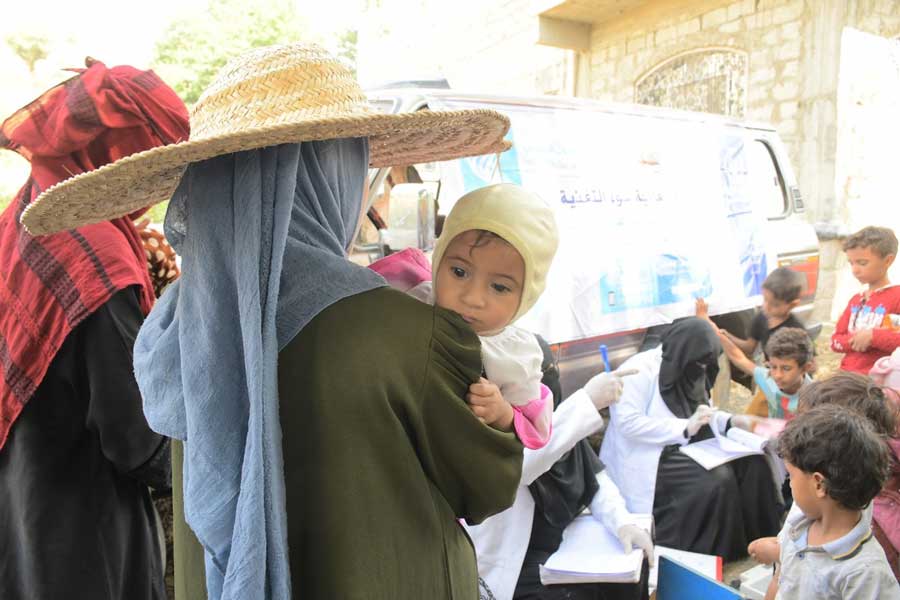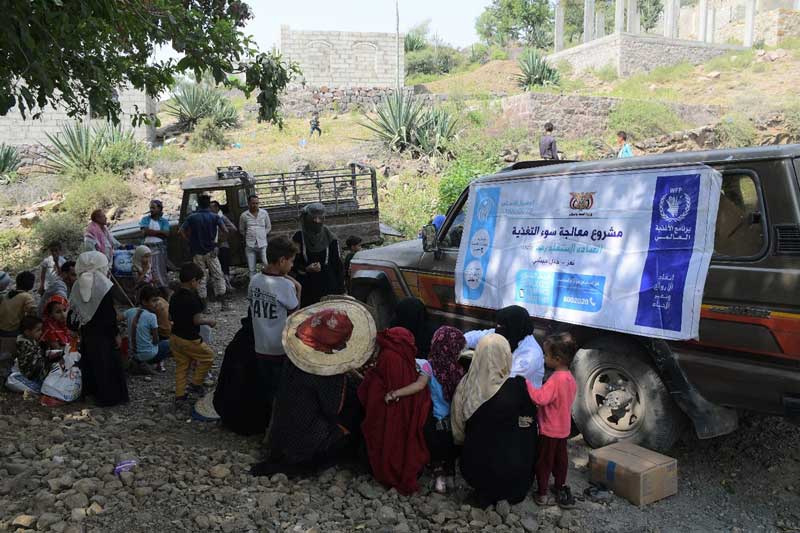
Fighting malnutrition in all its forms is one of the greatest public health challenges in the world, with serious and lasting repercussions for individuals, their families, communities, and countries. Women, infants, children, and adolescents are particularly at risk of malnutrition, and it is therefore essential to invest in nutritional needs.
After more than eight years of devastating conflict in Yemen, malnutrition has become a major concern in many parts of the country. The deterioration of health services, the economic crisis, the decline in purchasing power, and the difficulty of obtaining safe drinking water have increased malnutrition rates. As a result, access to health, nutrition, and other life-saving services has become more difficult.
In its recent report, the United Nations Children's Fund (UNICEF) reported that 2.2 million Yemeni children suffer from acute malnutrition, of whom more than 540,000 suffer from severe acute malnutrition, which is a life-threatening condition if not treated urgently. Meanwhile, the rate of malnutrition among mothers has increased by 25%, putting women and newborns at risk.
Children and women are among the most vulnerable groups amidst conflicts. The ongoing conflict in the country has severely affected people's resilience, as it has weakened the ability of many families to have access to nutritious, safe and affordable food, such as fresh fruits, vegetables, legumes, meat and milk, and has had dire effects on those families and the health of their members.
HUMAN ACCESS has always been present in Yemen for the past eight years and beyond. It continues to actively work to provide much-needed food assistance, ensuring the availability of specialized nutritious foods for women and children who need it most. Through its specific and sensitive nutrition interventions, it can address malnutrition and prevent further deterioration.
What does malnutrition mean?
The appearance of malnutrition in a person indicates that there is a deficiency, excess, or imbalance in that person's intake of energy or nutrients.
The term malnutrition covers three broad groups of health conditions. The first is undernutrition, which includes wasting (low weight-for-height), stunting (short stature-for-age), and underweight (low weight-for-age).
The second is micronutrient malnutrition, which includes micronutrient deficiencies (lack of important vitamins and minerals) or micronutrient overabundance. The third group is overweight, obesity and diet-related noncommunicable diseases (such as heart disease, stroke, diabetes and some cancers).
A number of factors are causing an increase in malnutrition among children under five, pregnant and lactating women, including armed conflicts, extreme climatic phenomena, the COVID-19 pandemic, economic and living crises, high levels of poverty, unemployment, and many others.
The war in Ukraine has affected imports and food shortages amid soaring prices of basic commodities, including wheat, edible oils, and fuel. This led to catastrophic levels of malnutrition in countries experiencing conflicts, such as Yemen, which is considered one of the centers of global hunger, according to previous UN assessments.
Proper nutrition changes the game, as well-nourished people are more likely to be healthy, productive, and able to learn. Iodine, iron and vitamin A are among the most important substances of global public health, and their deficiency represents a major threat to health.
Investing in the prevention and treatment of malnutrition saves lives and prevents more vulnerable children and women of childbearing age from being at risk. Studies show that improving nutrition is not only a life saver, but it is also a smart investment, as every US dollar invested in nutrition saves the country $10 in return.
Figures paint a bleak picture
Data distributed by the United Nations World Food Program (WFP) at the beginning of this year showed that 3.5 million people in Yemen, including 1.3 million pregnant or breastfeeding women and girls, suffer from acute malnutrition. And that nearly half of Yemeni households (49% nationally) suffer from inadequate food consumption, with very high rates in 15 out of 22 governorates.
Statistics indicate that one out of every five children under the age of five in various parts of Yemen suffers from acute malnutrition, and that 45% of children suffer from stunting, and over 86% suffer from anemia. The numbers are expected to rise due to the ongoing crisis in the country.
In a recent analysis of the Integrated Phase Classification of Food Security for Yemen, issued last May, the Food and Agriculture Organization of the United Nations (FAO), the World Food Program (WFP), and UNICEF confirmed that some Yemeni regions are still suffering from critical levels of acute malnutrition.
In a report on the humanitarian situation in Yemen during the first half of this year, issued last June, the United Nations Office for Humanitarian Affairs (OCHA) described malnutrition in the country as complex.
According to the report, it was a complex mix of factors involved, including food insecurity, poor food quality, measles outbreaks, low coverage of vaccination campaigns, limited access to clean water and sanitation, and a high proportion of infectious diseases.
As a result of high levels of disease and poor access to health care, the UN office stated that stunting has been reported at very high levels, leading to an overall loss due to reduced cognitive and physical development, decreased productivity capacity, poor health, and increased disease risks.
On how to address this situation, the Humanitarian Affairs Office stated that urgent action is needed to address the underlying drivers of food insecurity, including conflict, economic decline, and lack of humanitarian assistance. It further warned that inaction could lead to a more severe humanitarian crisis, disease outbreaks, suboptimal nutritional practices, and the decline of the already poor nutritional status.
Endless cycle of poverty and ill health
Undernutrition leads to vulnerability to disease and death, especially for children. According to UN reports, approximately 45% of deaths of children under the age of five are related to undernutrition, and most of these deaths occur in low-and middle-income countries.
Malnutrition increases healthcare costs, takes terrible toll on the most vulnerable children, and has devastating consequences for the lives and well-being of women. Poverty exacerbates the risks of malnutrition, as people living in poverty are more vulnerable to various forms of malnutrition. They are forced into desperate measures to feed themselves and their families, which has major repercussions on physical and mental health.
An unhealthy diet and malnutrition are also major risk factors for cardiovascular disease, as inadequate nutrition leads to poor cognitive development and weakens the immune system. According to UN reports, weakened immune systems increase the risk of death among these children under the age of five by up to 11 times compared to well-nourished children.
In previous statements published by the United Nations News, UNICEF Executive Director Catherine Russell said: "Malnutrition is a major threat to the survival, growth and development of children.” She added that the scale of the nutrition crisis requires a stronger response focused on children, stressing that the global hunger crisis is pushing millions of mothers and their children towards hunger and severe undernutrition, and "without urgent action from the international community, the consequences of this may continue for many generations to come."
FAO Director-General QU Dongyu said the situation is likely to deteriorate further in 2023. He stressed the need to ensure availability, affordability and access to healthy diets for young children, girls, and pregnant and lactating women, adding: “We need urgent action to save lives now, address the root causes of acute malnutrition, and work together across all sectors”.
For his part, the Director General of the World Health Organization (WHO), Dr. Tedros Adhanom Ghebreyesus, said: “People need access to affordable and nutritious food as well as support during these difficult times.” "Lack of food and nutrition weakens people's immune system and increases their risk of disease," he continued. Dr. Tedros added that malnourished children are more likely to die from pneumonia, diarrheal diseases and measles.
The 18 districts served by HUMAN ACCESS
HUMAN ACCESS is responding to the massive malnutrition crisis in Yemen. As a result, it strives to prevent all forms of malnutrition by improving children's and women's access to nutritious and safe diets and promoting optimal nutrition, hygiene and care practices for children and women for the health and well-being of all.
During six months, specifically from January to June 2023, HUMAN ACCESS succeeded in reaching 79,422 children and pregnant and lactating mothers, through the emergency support project for the most vulnerable groups - children under five years and pregnant and breastfeeding mothers - with curative and preventive feeding services, with funding from WFP.
The project targeted 18 districts in three governorates severely affected by the conflict. Those districts are Al-Qahirah, Mashra’a & Hadnan, Al-Misrakh, Jabal Habashi, Al-Mawasit, and Al-Waze’iya in Taiz Governorate, and the districts of Al-Malah, Al-Musaymir, Al-Madharibah & Al-Arah, Al-Maqatirah, Radfan, Al-Hadd, Habeel Jabr, and Tur Al-Baha in Lahj Governorate, as well as the districts of Marib City, Marib Al-Wadi, Harib, and Raghwan in Marib Governorate.
The project helped save the lives of severely malnourished children under the age of five and improved the nutritional status of pregnant and lactating women.
With the involvement of 603 volunteers, the project also helped prevent acute malnutrition by promoting preventive food and micronutrient support, in addition to health awareness and education, through 121 fixed health facilities, 216 food distribution points, and 14 mobile clinics.
The child Samad Jamil, 10 months, Rahaf Saif, 24 months, Muhammad Badri, 7 months, and Zainab Samer, 25 months, are just simple examples of children who were suffering from malnutrition with sunken eyes and slender bodies. Thanks to this project, they were able to recover, and the smile did not leave their lips after their relatives had given up on their survival. These people are now deeply grateful that this project has helped their children survive, recover, and lead healthy lives.
In a special statement, Dr. Abdulwase Alwasei, Secretary-General of HUMAN ACCESS, said that the emergency support project with curative and preventive nutrition services for the most vulnerable groups - children under five years of age and pregnant and breastfeeding mothers - in three governorates has a fundamental role in saving lives.
Additionally, the project provided the necessary assistance to enable beneficiaries to stand on solid ground, and it came at a time when this type of assistance is increasingly needed.
Dr. Alwasei explained that addressing malnutrition is one of the main priorities for HUMAN ACCESS, and it simply cannot stop now, since a generation is at risk in light of the deteriorating food situation in Yemen and the decline in access to healthy diets for vulnerable groups.
The Secretary General stressed that there is a need to invest in basic nutrition programs and avoid terrible consequences for children and women due to catastrophic levels of malnutrition.



